Basics of model editing
Overview
In Next Design, you can edit models while switching the model representation format (view).
Model editing is mainly done in the main editor in the center of the screen and the sub-editor that can be displayed side by side.
By using the main editor and sub-editor, you can edit different models side by side, or edit the same model in different views.
In addition, the model navigator also allows you to add models and change the model structure while getting an overview of the model structure in a tree format.
The following explains the basic operations for editing models in Next Design in the following order.
- Editing in the Main Editor
- Editing in Sub Editors Side-by-Side
- Editing in the Model Navigator
Editing in the Main Editor
Selecting a Model
To select a model to edit in the Main Editor, follow these steps:
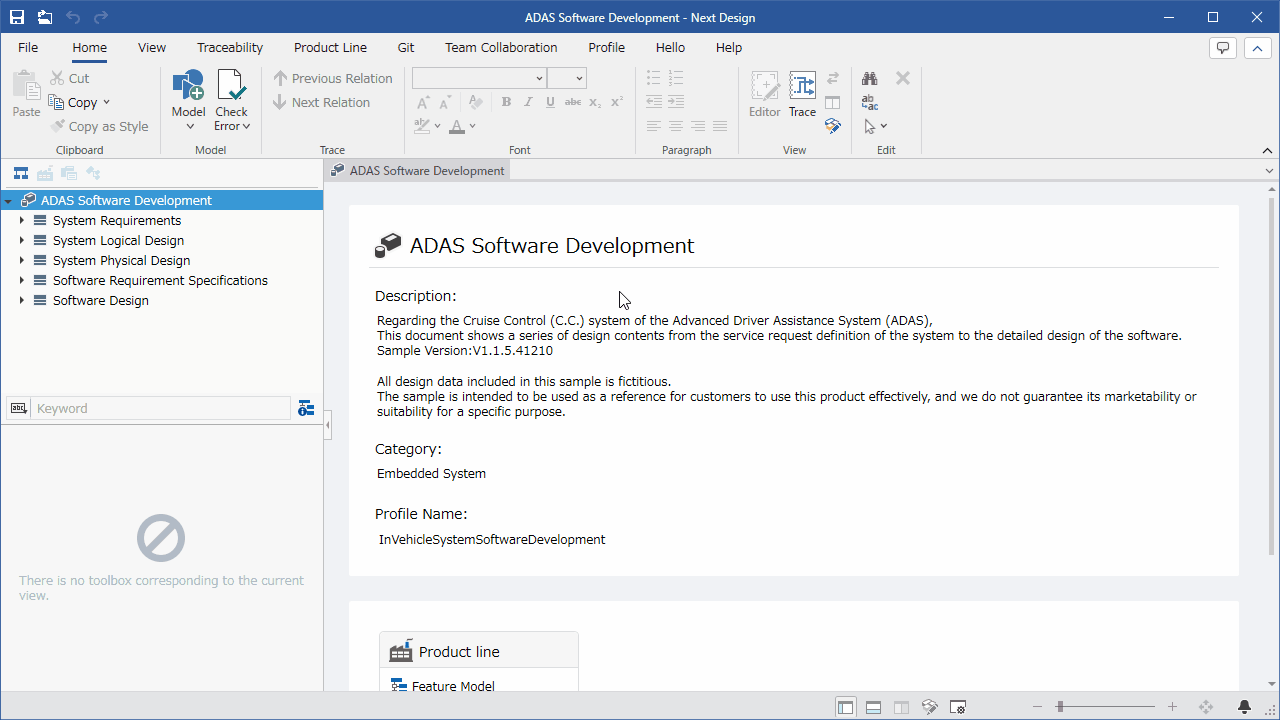
- Expand the tree in the Model Navigator to find the model you want to edit.
- Click the model in the Model Navigator to display it in the Main Editor and make it available for editing.
- If the Main Editor is not displayed, click [Home] > [View] > [Editor] on the ribbon to switch screens.
Switching Views
To switch the view of a model, follow these steps:
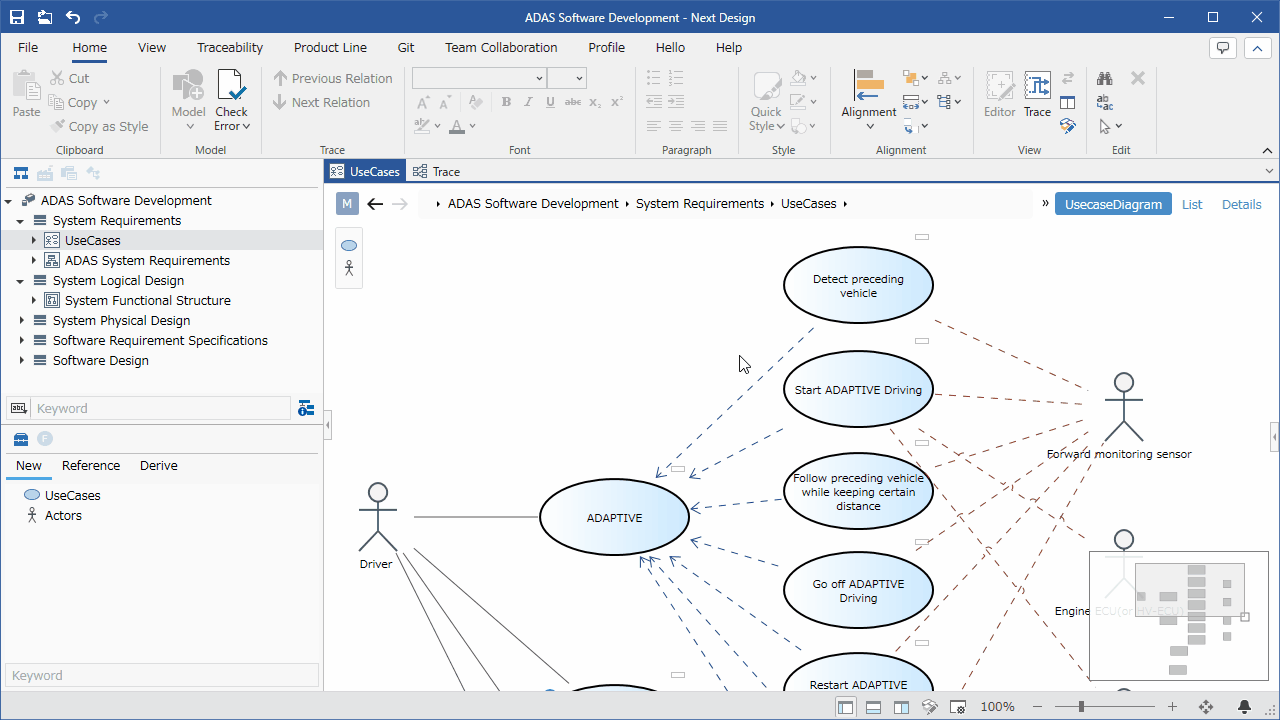
- When the model to be edited is displayed in the editor, buttons to switch the representation format (view) of the model are displayed in the upper right of the editing area.
- Click the button to switch the view.
(In the above example, you can select from three views: Use Case Diagram/List/Details) - Editing the model in one view is automatically reflected in the other views.
- The views available for model editing differ depending on the model type (entity).
- The available views can be customized in the profile.
You can collapse the view list to view the information displayed at the top of the editor, such as the path bar, in a wider area.
How to operate:

How to use
- If two or more views are displayed in the list, you can collapse the view list by clicking the [≫] button.
- If a view is collapsed, you can uncollapse the view list by clicking the [≪] button.
- If a view is collapsed, hover the mouse over the view switch button to display all views.
Add a model from the toolbox
To add a model in the diagram view, follow these steps:
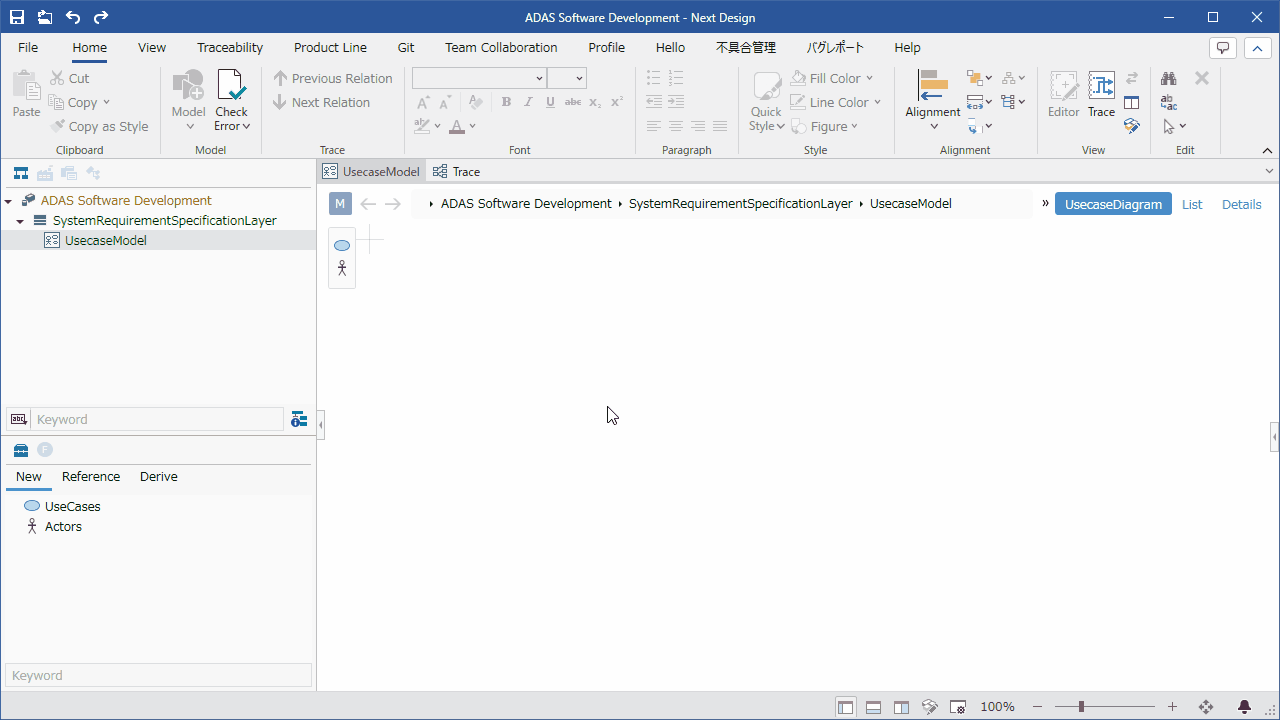
- The toolbox below the model navigator displays the types of models that can be added.
- Select the model type you want to add, and drag and drop it from the toolbox onto the view to add the model to the diagram.
- For details, see the explanations for each view type.
- Models can also be added from the subtoolbox displayed to the left of the editing area of the editor.
Delete a model
To delete a model in the editor, follow the steps below.

- Select the model you want to delete in the editor.
- Do one of the following:
- Click the [Delete model] command in the context menu.
- Press the delete key.
- The model is deleted from the editor.
Editing sub-editors side by side
Displaying the sub-editor
To display the sub-editor, follow the steps below.
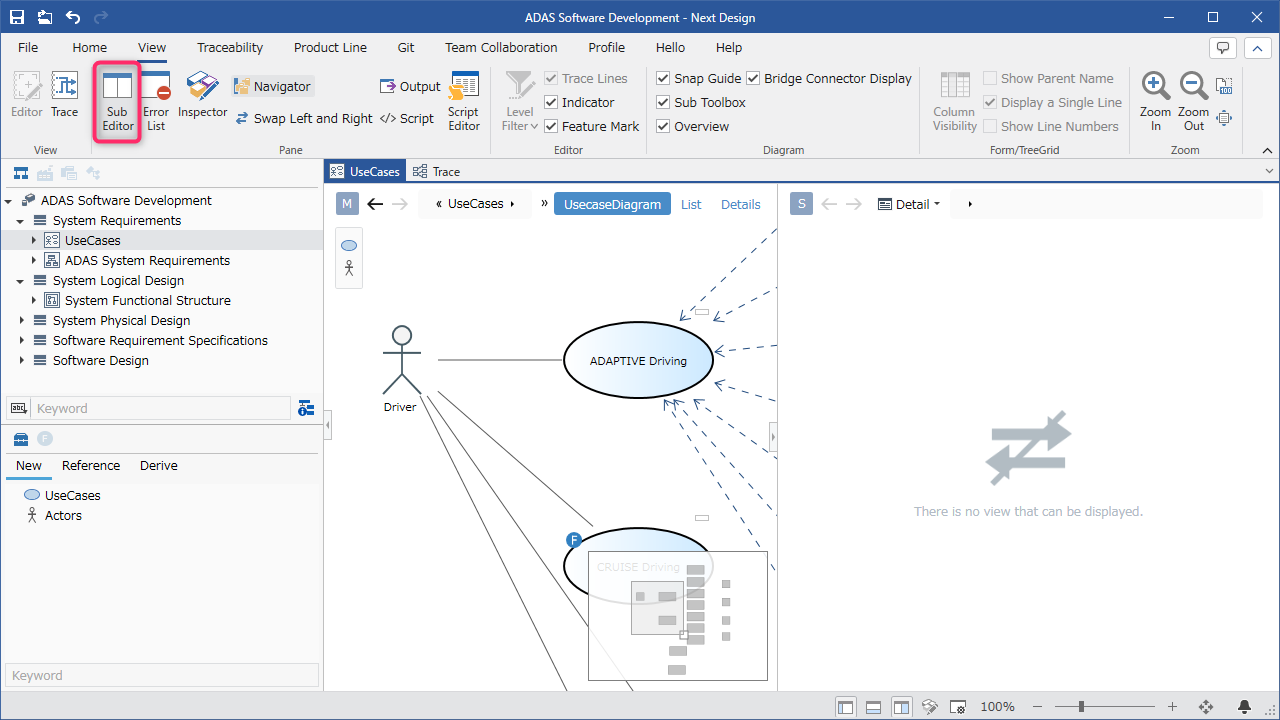
- From the ribbon, click [View] > [Pane] > [Sub Editor].
- Each time you click, the display will toggle between visible and hidden.
Switching the model to edit
- Switching from [Display Mode]
To switch the model to display and edit in the sub-editor, follow the steps below.
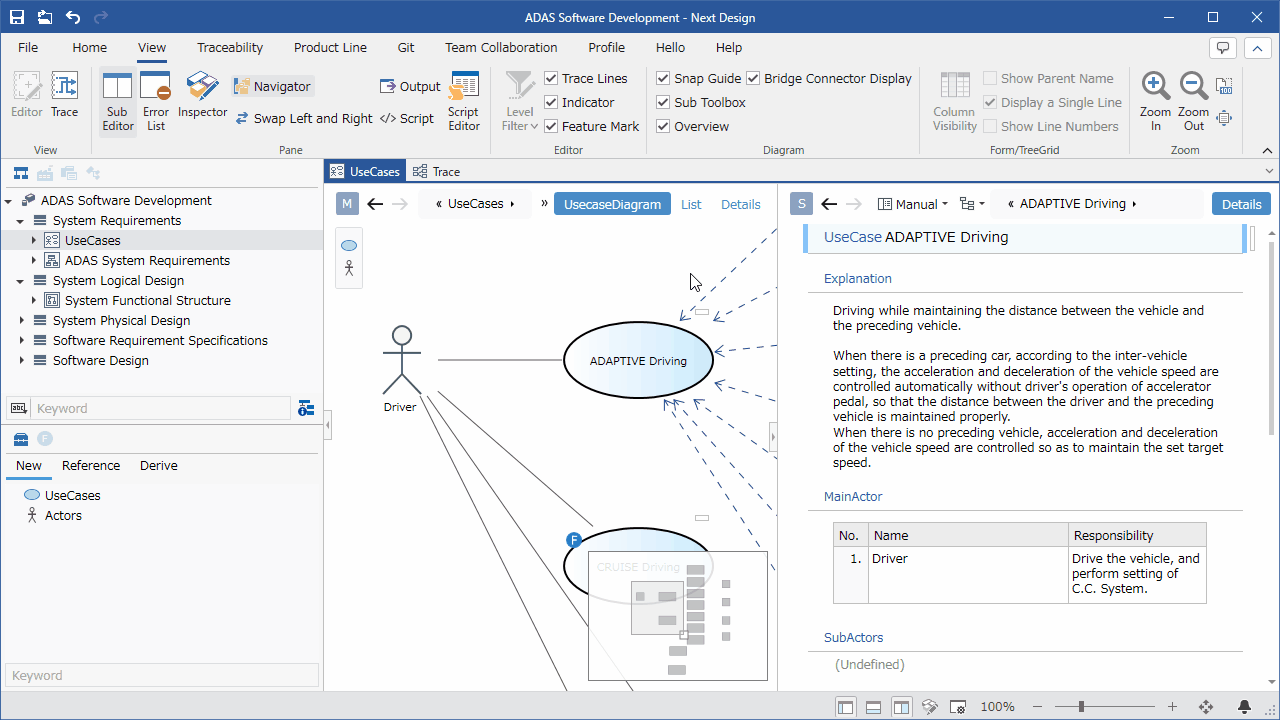
- From the [Display Mode] drop-down list at the top of the sub-editor, select one of the options in the table below.
- If you selected [Manual] for the display mode, or if there are multiple models that correspond to [Input (Deep Blue)] or [Output], select the model to display from the pull-down list that appears to the right of [Display Mode].
| Display Mode | Model to display |
|---|---|
| Manual | Any model specified in the sub-editor |
| Detail | Model selected in the main editor |
| Detail (Type) | Model specified as the type of the lifeline or message selected in the sequence diagram |
| Input (Deep Blue) | Model that is the input of trace information |
| Output | Model that is the output of trace information |
| Same as Main | Model edited in the main editor |
- Switching from the Model Navigator
To switch the model to be displayed and edited in the sub-editor from the Model Navigator, follow the steps below.
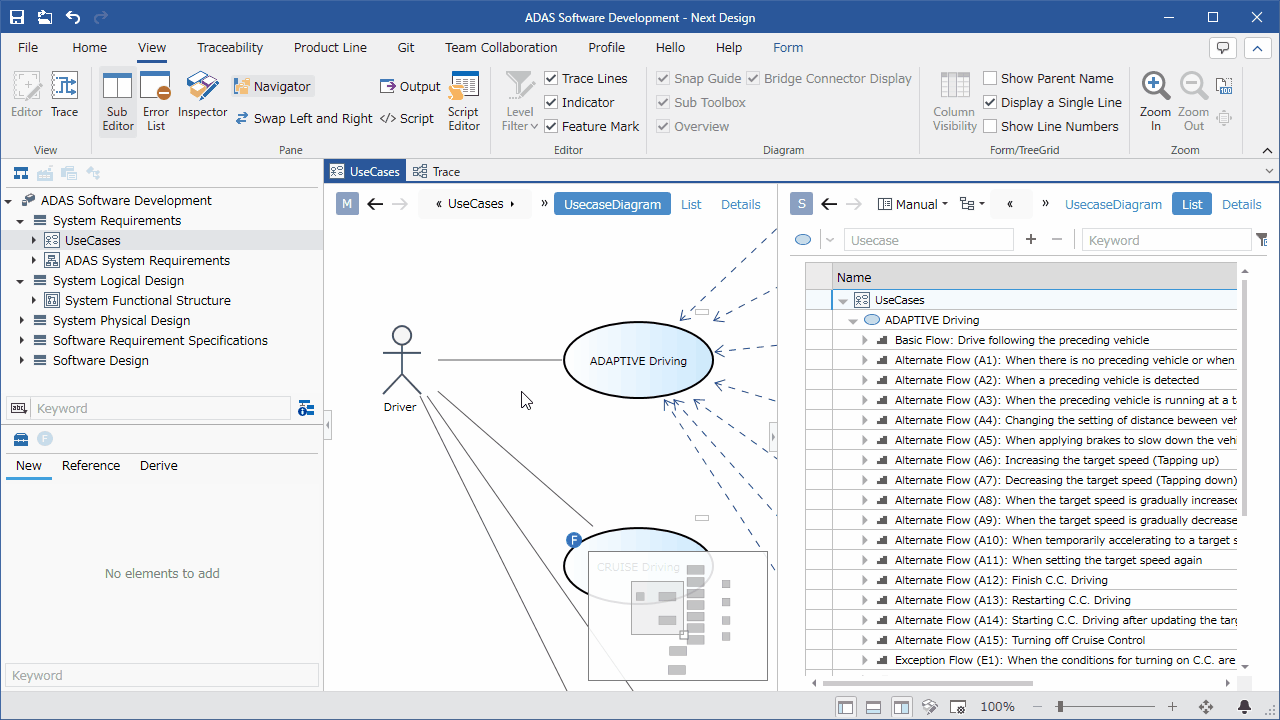
- Click and hold the mouse to select a model on the Model Navigator. (When you release the click, the display of the Main Editor will change.)
- Drag and drop it to the top of the Sub Editor.
- If you switch the display of the Sub Editor from this operation, the model on the Model Navigator will be displayed in the Sub Editor while the model selected in the Main Editor remains.
- For the characteristic usage of the Sub Editor, see Modeling > Cross-Process Modeling > Design Method in Next Design.
Switching views
To switch the view of the Sub Editor, click the view option displayed in the upper right of the editing area, just like in the Main Editor.

Editing with the Model Navigator
Adding a model
To add a model with the Model Navigator, follow the steps below.
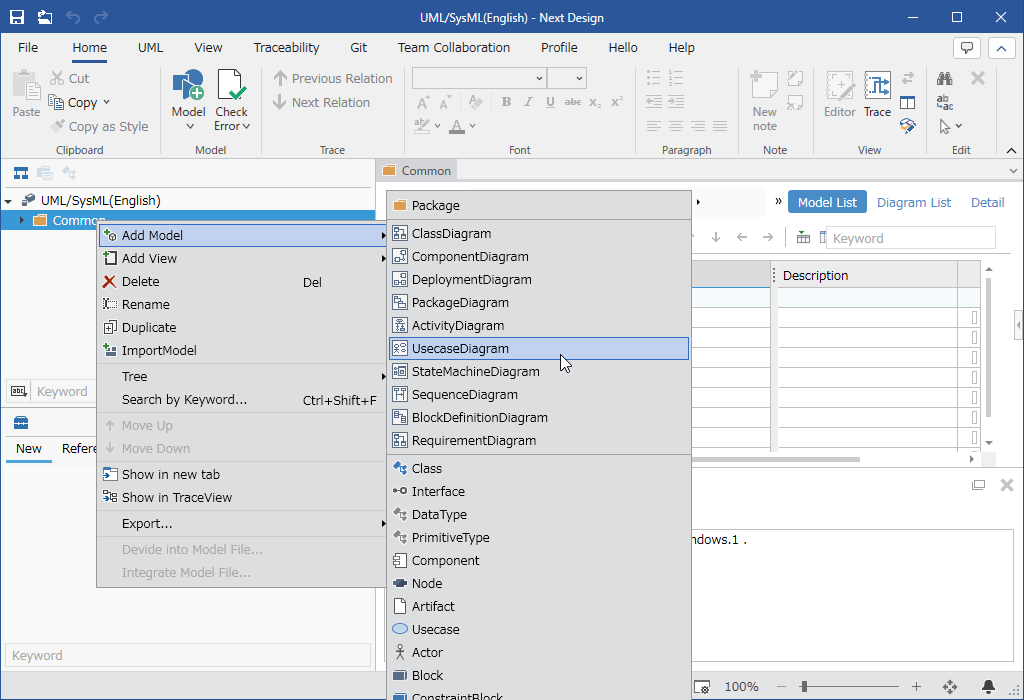
- Right-click a model in the Model Navigator to open the context menu.
- Under the [Add Model] command in the context menu, the types of models (entities) that can be added are displayed.
- Click the type of model you want to add from among them, and the model will be added as a child of the target model.
- The entities that can be added depend on the parent entity in the hierarchical structure, and are defined in the profile.
Duplicating a model
To add a model with the same structure by duplicating an existing model and its descendants, follow the steps below.

- Select the model to be duplicated in the Model Navigator.
- Click the [Clone] command in the context menu.
- The duplicated model is added immediately after the selected model.
-
The following contents are duplicated based on the model to be duplicated.
-
Field input value 1
-
Descendant models owned by the target model
-
Relationships in which the target model is the related source
-
If the related destination is included in the duplication target, the related destination is the duplication target model
-
If the related destination is not included in the duplication target, the related destination is the same as the related destination of the duplication source model
-
Model order relationship in the ownership and reference fields of the target model 2
-
Editing information in each view (such as shape position in ER diagram)
-
The following contents are not duplicated.
-
Feature assignments and feature condition expressions
-
Relationships to which the target model is the associated destination
-
Model colors set in forms and tree grids
- If a model cannot be added due to a multiplicity constraint, the message "Cannot be cloned because the multiplicity constraint is exceeded" is displayed and the model is not cloned.
Move a model
To change the order of models in the model navigator or change the hierarchical structure, follow the steps below.
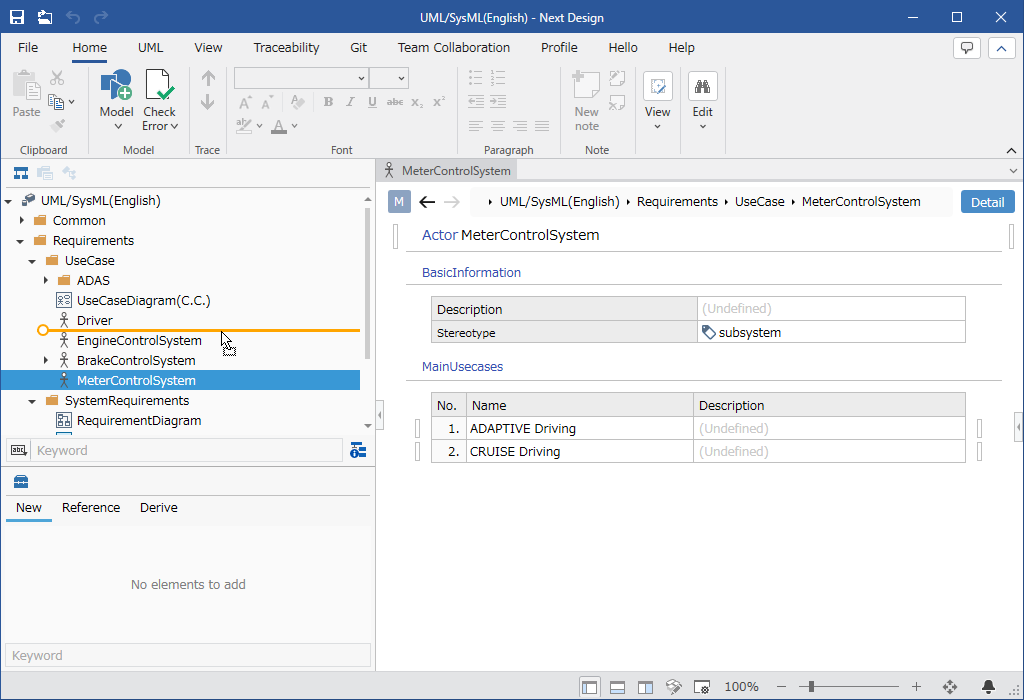
- To change the order of models, drag and drop the target model on the tree.
- To move a model to a different parent and change the hierarchical structure, drag and drop the target model on top of another parent on the tree.
- Models in the same hierarchy are displayed classified by entity, so they cannot be moved between different entities. The order of entities can be customized in the profile.
- When moving to a different parent, the entity to be moved can only be moved if it can be added to the parent entity of the destination.
Open multiple models simultaneously for viewing and editing
Display in multiple tabs
Display in multiple tabs to switch between multiple models for editing.
To display in multiple tabs, follow the steps below.
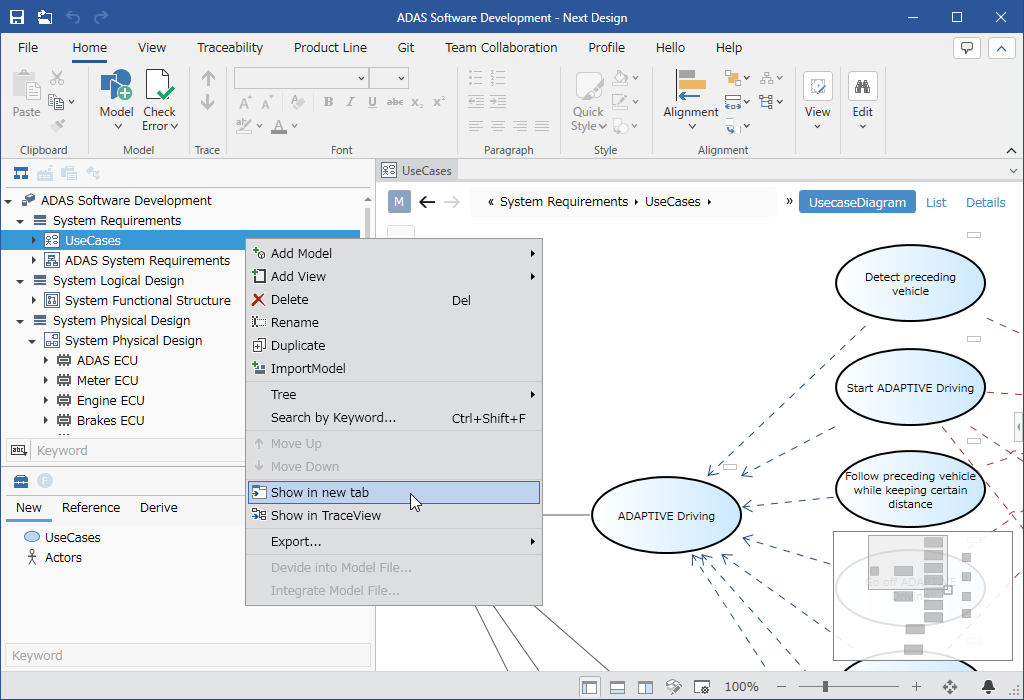
- Select the model you want to edit from the model navigator/editor and execute the [Show in new tab] command from the context menu.
(You can also select multiple models and execute this command) - The selected models will be displayed in new tabs.
You can also display them in new tabs by the following operation.
You can also display tabs by selecting a model and dragging and dropping it into the tab area.
This operation can be performed in the model navigator/the following forms.
- Document form
- Tree grid form
- The tab that is displayed on the far left when you open a project is called a pinned tab. The following operations cannot be performed on pinned tabs.
- Display in a floating window
- Display in docked mode
- Change the order of tabs
- Close a tab
- When you open a project, the tab state from the last time you closed the project will be restored.
- The pinned tab will become the active tab.
- You can restore up to 30 tabs, including pinned tabs.
Display in docked mode
You can edit multiple tabs side-by-side on one screen.
To display in docked mode, follow the steps below.
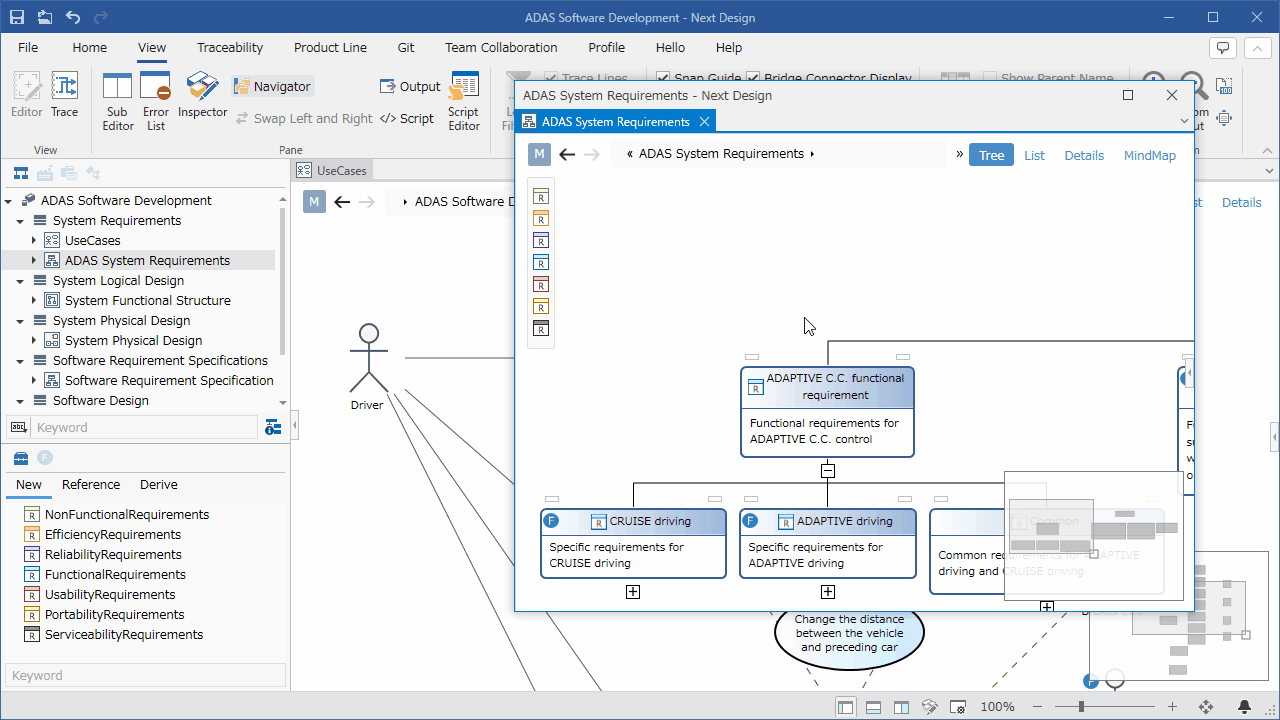
- Drag the tab into the Model Editor area.
- A docking area guide will appear, so drop it into the area you want to dock it into.
- The tab will be docked into the area you dropped it into.
Display in a floating window
You can place the model in any position by displaying it in a floating window.
You can display multiple floating windows, and you can also display them in multi-tabs or docked within them.
To display in a floating window, follow the steps below.

- Drag the tab and drop it in the desired position.
- The tab will be displayed in a floating window.
Common operations
Duplicate a model in the editor
To duplicate a model that is not displayed in the model navigator, follow the steps below.
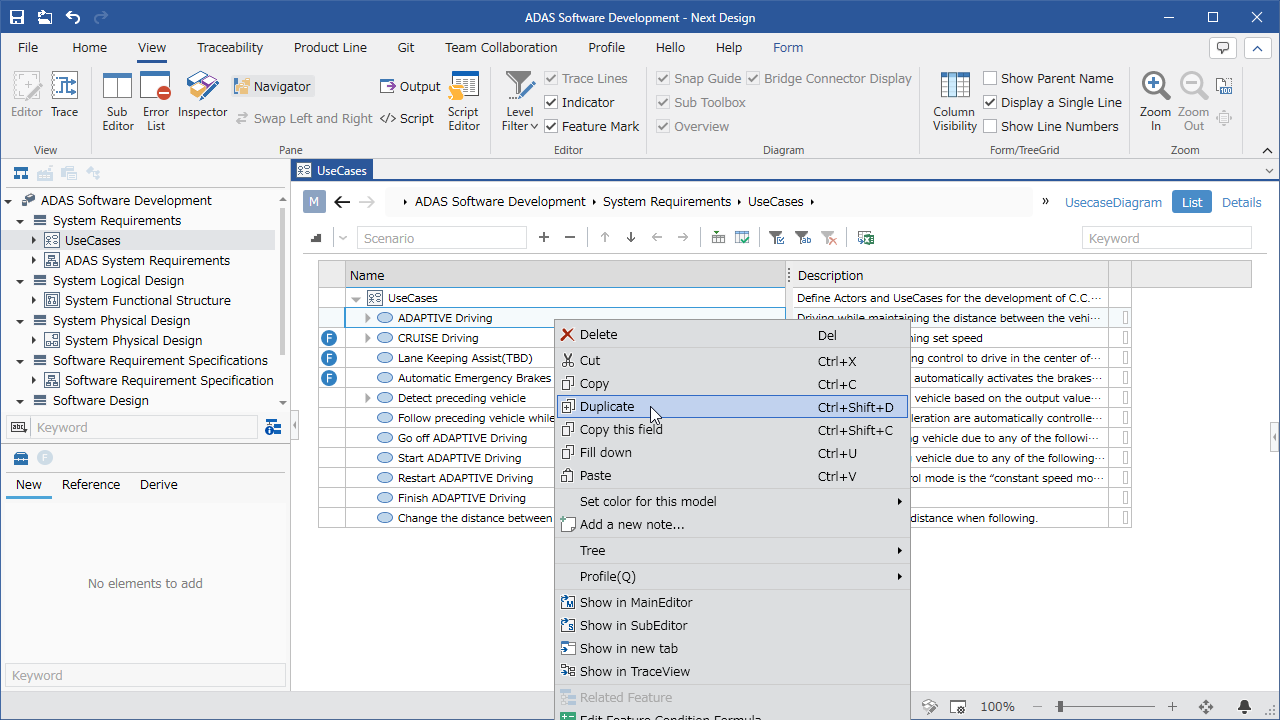
- Select the model to duplicate in the editor.
- Click the [Clone] command in the context menu.
- The duplicated model is added immediately after the selected model.
- For information and precautions regarding duplication, see Editing in the Model Navigator > Duplicating a Model.
Importing a Model
To import a model from another project into your own project, follow the steps below.
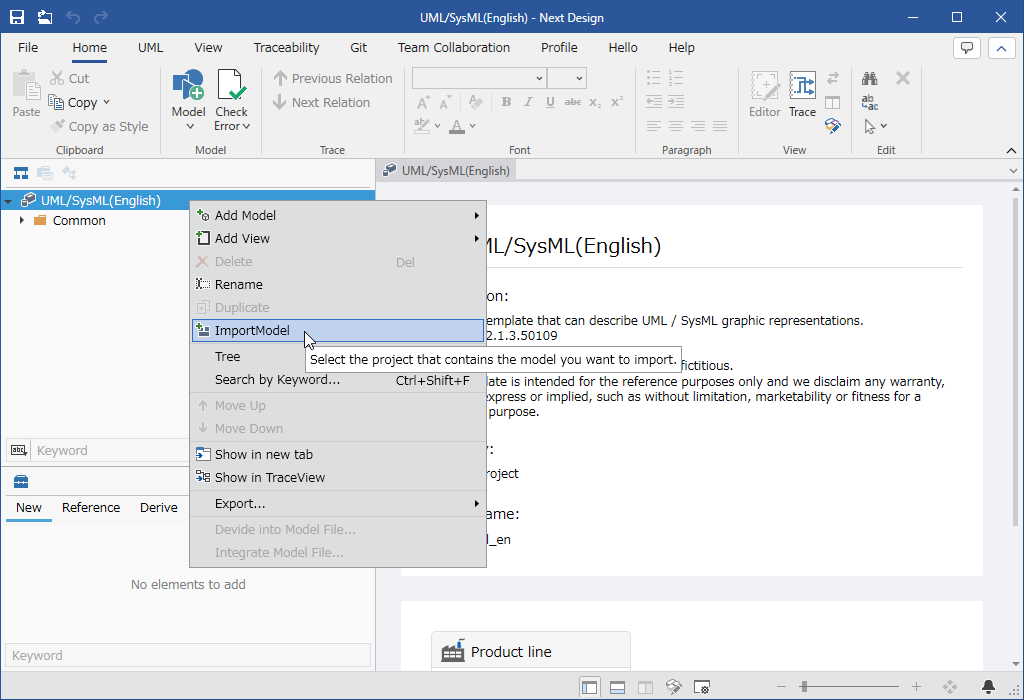
- Select the root project or model in the Model Navigator.
- Click the [ImportModel] command in the context menu.
- In the [Import Model] dialog box, select the project file (.nproj or .iproj) and click the [Open] button.
- The imported model is added under the root project.
- If there is no metamodel corresponding to the model to be imported in your project, the import process of that model will be skipped and the import will continue.
- If you select a model in the model navigator and import it, models that the selected model can own will be imported under it, and other models will be imported under the root project.
- To import a model file exported from another project, see Modeling > Team Development > Distributed Development with a Team > Registering Model Files.
Footnotes
-
For fields with initial values, if the internal field value is null, the initial value is set at the time of cloning.
The value of the internal field that is null is set only when the model is created if there is no initial value, or via the extension API. ↩ -
"Relations to which the target model is the associated destination" are not cloned, so free indexes are moved forward. ↩